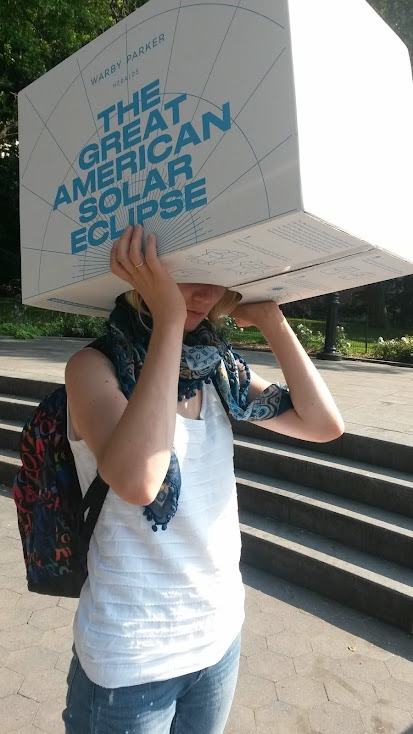Image: one of our WonderDome staff during the total solar eclipse of August 21, 2017
“Before you die, you owe it to yourself to experience a total solar eclipse”
(advice given to David Baron, a science writer and an umbraphile, by an astronomer he once interviewed)
Umbraphiles, from the word UMBRA, i.e. SHADOW in Latin, go by many names: eclipse chasers, shadow lovers and so on. These Astronomy fans cross continents, often venturing into the most remote parts of the world to witness SOLAR ECLIPSES. Or, to be more precise, the 3 minutes of TOTALITY, when the Sun gets completely covered by the Moon, that highlight the event. In reality, observing solar eclipses is anything but the ‘chase’. It takes a lot of planning and calculations to end up – at the right time in the right place – on a 100-or-so-miles wide strip of land or water, the PATH OF TOTALITY, from where the eclipse can be seen. There and only there you will get to stand in the shadow of the Moon.
They say a solar eclipse is something you have to experience at least once in your life. The catch is, once you saw it, you yearn for more. You become an umbraphile! The current records for the most solar eclipses observed – over 30 events each – belong to the US astronomer Glenn H Schneider, US astronomer Jay M. Pasachoff and New-Yorker John Beattie.
Have YOU seen a total solar eclipse yet?
Types of eclipses
Eclipses come in different flavours: There are lunar eclipses, that occur when the Sun, the Earth and the Moon line up so that the Moon passes through the Earth’s shadow. These events, although beautiful, last hours and can be seen from anywhere on the night side of the Earth.
And then there are much rarer events, solar eclipses, those that occur when the Sun, the Moon and the Earth line up. But not all solar eclipses are born equal! There are three types** of solar eclipses: partial, annual and total (ok, strictly speaking there is also a hybrid, a combination of an annual and a total eclipse). Out of the three, it is the total solar eclipses most umbraphiles are after.
**
When a partial solar eclipse happens, the Moon passes in front of the Sun off-centre, blocking only a part of the Solar disk.
When an annual solar eclipse happens, the Moon passes right in front of the Sun, but does not cover the entire Solar disk. As a result, we see a ‘ring of fire’ around the dark silhouette of the Moon.
When a total solar eclipse happens, the entire solar disk gets covered by the Moon.
The magic of totality
Remember how we always say ‘never look at the Sun directly’? Well…unless it is during totality, the short phase of the total solar eclipse when the Sun is fully covered by the Moon. During those several minutes our star is only as bright as the Full Moon and you can – in theory (best to still use eye protection)- take a peek at the Sun with your naked eyes. But almost as interesting as staring at our star is to observe how nature reacts to the sudden nightfall. Birds stop singing, flowers close their petals, insects hurry back home. Everything gets still and quiet and shall we say…magic?
Are total solar eclipses useful for science?
Absolutely! From studying solar activity to learning about lunar composition, eclipses have been providing us – and still do – with unique opportunities to explore our celestial neighbours. For instance, during the historic eclipse of May 29, 1919 Sir Arthur Eddington was able to prove Einstein’s general theory of relativity by showing that – just as predicted by Einstein – the gravity of the Sun bends the light of the nearby stars.
An observation of an even earlier solar eclipse, that of August 18, 1868, led to the discovery of the new chemical element, helium.
A solar eclipse is the only time when you can see the Sun’s outer layer, CORONA, the mysterious and the least understood layer of the solar atmosphere. It appears as a wispy nimbus around the dark silhouette of the Moon.
So what are you waiting for? The next total solar eclipse, the eclipse of December 4, 2021, is coming up soon! Time to get packing!
Useful sites and further reading
Author: Irina Vladimirova
Irina Vladimorova is a presenter at WonderDome Planetarium and a regular contributor to WonderDome Astronomy Blog. She holds a degree in Astrophysics and a special place in her heart for planetary science.

